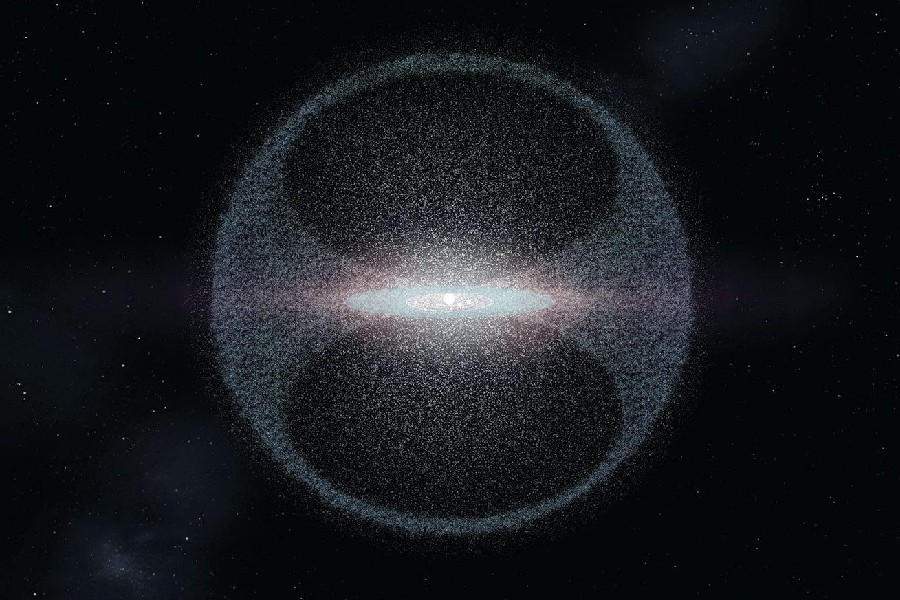As we peer into the outer reaches of our Solar System, a mysterious halo of icy bodies awaits discovery known as the Oort cloud. Shrouded in darkness billions of miles from the Sun, unraveling where this elusive region may be lurking astronomers. So, where is the Oort cloud located? Is the Oort cloud in our Solar System?
This guide provides an overview of the theories surrounding the Oort Cloud. It elucidates why its vast distance renders direct observation nearly impossible with contemporary technology.
Readers will learn how scientists have postulated its presumed spherical configuration, spanning nearly a light-year from the Sun. They will also discover the compelling evidence that has guided them in inferring the location of Oort cloud.

Where Is the Oort Cloud Located?
The Oort Cloud is located in the outer reaches of the Solar System, far beyond the orbit of Pluto. It is a vast and mysterious region filled with icy bodies, including comets, that orbit the Sun.
But how far is the Oort cloud from the Sun? The Oort Cloud’s exact location is not precisely defined. It is generally believed to begin at about 2,000 astronomical units (AU) from the Sun. The Oort Cloud extends to the outermost reaches of the Sun’s gravitational influence, possibly reaching up to 100,000 AU or more.
This distant and elusive cloud is a reservoir of ancient remnants from the early Solar System. It provides valuable insights into the formation and evolution of our celestial neighborhood.
General Description
The Oort Cloud emerges as a vast and intriguing cosmic realm, occupying the outermost boundaries of our Solar System. It is composed primarily of icy bodies.
It extends across immense distances, becoming a reservoir of celestial remnants with a size that defies conventional measurement. This enigmatic cloud serves as a testament to the Solar System’s history, offering a preserved record of its early stages.
Their pristine icy compositions play a crucial role in unveiling valuable insights. These insights contribute to our understanding of the origins and evolution of our cosmic neighborhood.
Spherical Cloud
The Oort Cloud presents a fascinating celestial spectacle with its unique three-dimensional structure. It is defined by a spherical nature that envelops the outer reaches of the Solar System.
This cosmic geometry forms a spatial expanse extending in all directions, creating a celestial realm that encapsulates our Solar System. Within this spherical cloud, comets and various celestial bodies navigate gracefully. Their distribution is intricately woven into the fabric of the Oort Cloud.
The harmonious orbital patterns of these cosmic wanderers contribute to the celestial choreography. This makes the spherical cloud not just a spatial configuration but a dynamic and captivating celestial stage where comets and celestial bodies perform their cosmic ballet.
Elliptical Orbits
The Oort Cloud is where celestial bodies predominantly follow elliptical orbits, creating dynamic and intricate pathways through space. These elliptical trajectories characterize the cosmic journey of comets and other objects within this distant region.
As these celestial wanderers navigate their elliptical orbits, they are subject to the gravitational influences exerted by the outer Solar System. External forces from distant planets and massive celestial bodies shape and mold the elliptical paths within the Oort Cloud.
The elliptical nature of these orbits adds complexity to the celestial dynamics within the Oort Cloud. It also provides valuable insights into the gravitational interplay that governs this distant cosmic neighborhood.

Outer Edge
The outer boundary of the Oort Cloud, marking the theoretical limits of our Solar System, is challenging to define due to its distant and elusive nature. Conceptualized into inner and outer regions, the outer Oort Cloud extends far beyond 50,000 astronomical units (AU), where the Sun’s gravitational influence weakens significantly.
Objects near this boundary transition from being primarily affected by the Sun’s gravity to being influenced by passing stars and the galactic tide, indicating the onset of interstellar space. While speculative, theoretical models suggest the outer edge could extend up to 100,000 AU.
Beyond this point, comets and icy bodies may venture into interstellar space, free from the Sun’s gravitational bonds. Advancements in observational techniques aim to refine our understanding of this boundary, shedding light on the mysterious realm that marks the outer reaches of our Solar System.
Nearest Stars to the Oort Cloud
The Oort Cloud, a vast and mysterious region on the outskirts of our Solar System, extends its influence toward neighboring stars beyond the confines of our sun’s gravitational reach. Probing the proximity of the Oort Cloud to these stellar neighbors reveals intriguing celestial relationships.
Among the significant stellar systems that share a cosmic neighborhood with the Oort Cloud, one candidate is the Alpha Centauri. Situated a mere 4.37 light years away, it is the closest star system to our Solar System. The gravitational interplay between the Oort Cloud and Alpha Centauri raises questions about potential influences on long-period comets and other celestial bodies dwelling within the Oort Cloud.
In addition to Alpha Centauri, Barnard’s Star system emerges as another notable cosmic neighbor. Approximately 5.96 light years distant, it captures attention for its relative proximity and potential gravitational interactions with the Oort Cloud.
These close stellar relationships underscore the intricate interstellar dynamics that shape the Oort Cloud’s environment. As astronomers delve into the details of these cosmic connections, a deeper understanding of the celestial ballet between the Oort Cloud and its neighboring stars continues to unfold.
The Discoverers: Jan Oort & Ernst J. Opik
Jan Oort and Ernst J. Opik emerged as visionary astronomers whose collaborative efforts significantly advanced our understanding of the Oort Cloud. In parallel, Ernst J. Opik’s observational pursuits translated Oort’s theories into tangible evidence, affirming the existence of the Oort Cloud.
Their collaborative work bridged theoretical predictions with empirical observations. It also marked a pivotal moment in cosmic exploration. This solidified their legacy as key figures in uncovering the Oort Cloud’s secrets.
Conclusion
This article serves as a guide in the vast expanse of celestial realms reaching toward interstellar expanses. It illuminates the reader on the intricate dynamics, stellar influences, and groundbreaking contributions of Jan Oort and Ernst J. Opik.
So, where is the Oort cloud located? To conclude, the Oort Cloud resides in the outermost regions of the Solar System, extending well beyond the orbit of Pluto. And we hope you’ve realized the vastness encapsulated by the Oort Cloud.
The Oort Cloud, harboring celestial secrets, is an awe-inspiring testament to the cosmic wonders yet to be explored. As one delves into the cosmic boundaries of our Solar System, may their curiosity be continually ignited, propelling them into a journey of endless discovery.
